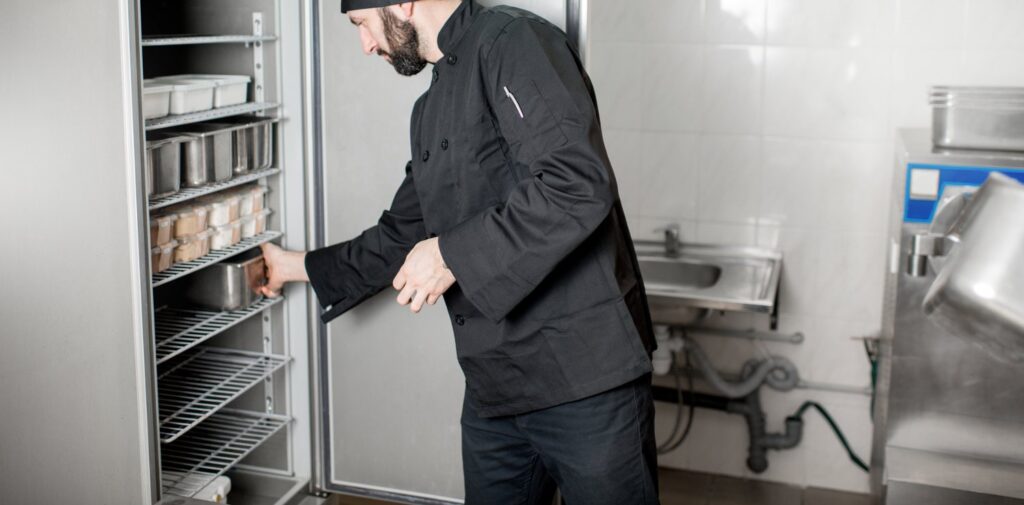Wireless Freezer Temperature Monitoring: Safeguarding Cold Storage
September 17, 2025How Can Wireless Freezer Temperature Monitoring Safeguard Cold Storage?
Wireless freezer temperature monitoring is a game-changing solution for protecting your valuable cold storage assets. With this technology, you no longer have to rely on manual temperature checks or worry about undetected temperature changes that could put your entire inventory at risk.
The Risks of Temperature Deviations in Cold Storage
Temperature fluctuations in cold storage environments can have serious consequences for businesses in various industries. Remote temperature monitoring helps reduce these risks by providing continuous oversight and instant alerts when conditions change.
Spoiled Products: A single equipment failure or power outage can lead to thousands of pounds worth of perishable goods going bad.
Regulatory Compliance Issues: Failure to maintain proper temperature control can result in violations of health and safety regulations, leading to fines or legal problems.
Health Hazards: Improperly stored food or pharmaceutical products can pose health risks to consumers.

The Importance of Precise Temperature Control
Maintaining precise temperature control is crucial for ensuring the safety and quality of cold stored items. Unfortunately, traditional monitoring methods often fall short in providing the continuous oversight needed.
Why Traditional Methods Are Insufficient
- Manual checks are time-consuming and prone to human error.
- Thermometers can be inaccurate or malfunctioning.
- Temperature data may not be recorded consistently.
How Modern Temperature Monitoring Systems Help
Modern temperature monitoring systems address these shortcomings by offering real-time data collection and instant alert capabilities. Here’s how they work:
- Temperature sensors are placed in freezers or cold storage areas.
- These sensors collect temperature readings every few minutes.
- The data is transmitted wirelessly to secure cloud platforms.
- You can access this information from any internet-connected device.
With this system in place, you receive immediate notifications whenever temperatures go outside acceptable ranges. This allows you to take quick action before any damage occurs.
The Benefits of Wireless Freezer Temperature Monitoring
Implementing wireless temperature monitoring systems can significantly reduce the risks associated with temperature fluctuations. Here are some key benefits:
- Proactive Management: Instead of reacting after a problem has occurred, you can proactively address issues as soon as they arise.
- Improved Visibility: With remote access to temperature data, you gain better visibility into your cold storage operations.
- Enhanced Compliance: By consistently monitoring temperatures, you can ensure regulatory compliance and avoid penalties.
This innovative approach transforms how you manage cold storage operations, providing peace of mind knowing that your perishable goods are being properly stored at all times.
What Exactly Is Wireless Freezer Temperature Monitoring and How Does It Work?
Wireless temperature sensors represent a sophisticated approach to freezer temperature tracking that eliminates the need for manual temperature checks and physical data logging. These systems consist of three primary components: the sensor unit itself, a wireless communication network, and a central monitoring platform that processes and displays the collected data.
The sensor units continuously measure ambient temperature within your freezer environment, typically taking readings every few minutes. This real-time monitoring capability ensures you capture even brief temperature fluctuations that could compromise your stored products. The collected data transmits wirelessly through various communication protocols, including Wi-Fi, cellular networks, or proprietary radio frequencies, depending on your facility’s infrastructure and coverage requirements.
Sensor Types and Power Options
Different sensor configurations suit various cold storage applications:
- Adhesive-backed sensors – Mount directly onto freezer walls or equipment surfaces for permanent installation
- Foil sticker sensors – Provide flexible placement options and easy repositioning as needed
- Probe-style sensors – Offer direct product temperature measurement for critical applications
Power options vary based on your operational needs:
- Battery-powered units – Deliver 1-3 years of continuous operation with lithium batteries, similar to those used in battery-powered ICP signal conditioners
- Wall transformer connections – Provide unlimited power for permanent installations
- Hybrid systems – Combine both options with battery backup for uninterrupted monitoring during power outages
The wireless transmission occurs automatically, creating an unbroken chain of temperature data that flows directly to your monitoring dashboard without human intervention.
More about: Automated Temperature Monitoring: Reducing Risk with Smart Technology
Why Is Continuous Temperature Monitoring Crucial for Cold Storage?
Temperature fluctuations in cold storage environments can destroy thousands of pounds worth of inventory within hours. Continuous monitoring benefits extend far beyond simple temperature tracking – they create a protective barrier that safeguards your entire operation against costly losses and regulatory violations.
Perishable goods require precise temperature control throughout their entire lifecycle. Fresh produce loses nutritional value and develops harmful bacteria when exposed to temperature variations, whilst frozen foods can suffer irreversible cellular damage during thaw-freeze cycles. You need real-time visibility into these conditions to maintain product integrity from storage through transportation.
Cold chain management becomes particularly critical in healthcare settings where vaccine potency depends entirely on maintaining strict temperature ranges. A single temperature excursion can render entire vaccine batches ineffective, potentially impacting public health outcomes and resulting in significant financial losses for healthcare providers.
Regulatory compliance demands comprehensive documentation of temperature conditions. Food safety standards require businesses to demonstrate consistent cold chain maintenance through detailed records. Wireless monitoring systems automatically generate this documentation, creating an audit trail that satisfies regulatory requirements without manual intervention.
Spoilage prevention through continuous data logging allows you to identify temperature trends before they become critical issues. You can spot equipment malfunctions, door seal problems, or power fluctuations early enough to take corrective action, preventing product loss and maintaining operational efficiency.
How Do Wireless Systems Alert Users to Temperature Deviations?
Modern wireless freezer temperature monitoring systems deliver alert notifications through multiple communication channels to ensure you never miss a critical temperature event. When sensors detect temperatures outside your predefined parameters, temperature threshold alerts activate immediately across various platforms.
Primary Alert Methods:
- Phone calls – Direct voice alerts for the most urgent temperature deviations
- SMS messages – Text notifications sent to multiple mobile devices simultaneously
- Email alerts – Detailed notifications with temperature data and timestamps
- Mobile app notifications – Push alerts through dedicated monitoring applications
- Dashboard alerts – Visual warnings on web-based monitoring platforms
Real-time alerts form the backbone of effective cold storage protection. You receive notifications within seconds of temperature threshold breaches, allowing immediate intervention before product integrity becomes compromised. This rapid response capability proves essential when dealing with high-value pharmaceuticals, vaccines, or premium food products where even brief temperature excursions can result in significant financial losses.
The multi-channel approach ensures redundancy in your alert system. If your primary contact method fails, backup notifications through alternative channels guarantee you receive critical temperature warnings. Many systems allow you to customise alert escalation procedures, automatically notifying additional team members if initial alerts remain unacknowledged within specified timeframes.
Wireless Freezer Temperature Monitoring: Safeguarding Cold Storage becomes most effective when alert systems provide actionable information, including specific sensor locations, temperature readings, and duration of deviations to guide your corrective response.
What Are the Installation and Maintenance Considerations for Wireless Freezer Temperature Monitoring Systems?
Installation ease becomes paramount when implementing wireless temperature monitoring solutions in your cold storage facilities. You can install most modern sensors without requiring professional technicians or disrupting your freezer operations. Adhesive-backed sensors attach directly to freezer walls or shelving units, whilst foil sticker variants provide flexible mounting options for irregular surfaces.
Sensor placement directly impacts the accuracy of your temperature readings across the entire cold storage area. Position sensors away from door openings where temperature fluctuations occur most frequently. You should install multiple sensors in larger freezers to capture temperature variations throughout different zones. Place sensors at mid-height levels rather than floor or ceiling positions to obtain representative readings of your stored products’ environment.
Strategic placement includes avoiding direct contact with frozen goods or packaging materials that might insulate the sensor from ambient air temperatures. You need clear line-of-sight between sensors and wireless receivers to maintain reliable data transmission.
Battery life maintenance varies significantly between sensor types and operating conditions. Standard battery-powered sensors typically operate for 2-3 years under normal freezer conditions, whilst extreme cold environments may reduce this timeframe. Wall transformer-powered sensors eliminate battery concerns entirely, providing continuous operation without replacement schedules.
You can implement backup power features through dual-power sensors that automatically switch to battery operation during mains power failures. Regular battery level monitoring through your wireless system dashboard prevents unexpected sensor downtime and maintains uninterrupted cold chain documentation.
Which Industries Benefit Most from Implementing Wireless Freezer Temperature Monitoring Solutions?
Several sectors depend heavily on precise temperature control to maintain product integrity and regulatory compliance. These industry applications span across diverse business environments where temperature deviations can result in significant financial losses and safety risks.
1. Hospitality Cold Storage
Operations in the hospitality industry, such as restaurants and hotels, face unique challenges when it comes to storing perishable ingredients. They often have multiple freezer units that store varying quantities of these ingredients. During busy service periods, kitchen staff may not have the time to conduct frequent manual temperature checks. This is where wireless monitoring systems become essential. By using these systems, hospitality businesses can ensure that food safety standards are maintained without having to rely on manual checks, thus reducing labour costs.
2. Healthcare Refrigeration
Facilities in the healthcare sector, including hospitals, clinics, and pharmaceutical companies, require strict temperature control for storing vaccines, medications, and biological samples. It is crucial for them to maintain precise temperature ranges in order to preserve the effectiveness of vaccines and comply with regulations set by health authorities. Any deviation from these temperature ranges can pose a risk to patient safety and result in expensive product replacement.
3. Aged Care Facilities
Aged care facilities have a dual responsibility of managing both food storage and medication refrigeration. This means they need monitoring capabilities that can address both these requirements simultaneously in order to protect their vulnerable residents.
4. Supermarkets
Supermarkets deal with large-scale cold storage across various sections of their stores where freezers are located. In such cases, relying solely on manual monitoring becomes impractical and susceptible to human error.
5. Food Manufacturing Companies
Food manufacturing companies face some of the most intricate challenges when it comes to maintaining temperature control throughout their operations – from production processes to storage facilities and distribution networks. These businesses require comprehensive monitoring systems capable of tracking temperatures across multiple areas while also providing detailed documentation for regulatory audits.
How Do Comprehensive Solutions Like Squizify Enhance Temperature Monitoring Practices in Cold Storage?
The Squizify platform represents a new generation of compliance solutions software that transforms traditional temperature monitoring into a comprehensive operational management system. This integrated approach combines hardware sensors with intelligent software to deliver complete visibility across your cold storage operations.
The platform’s strength lies in its tailor-made checklists that seamlessly integrate with wireless temperature sensors. You can create customised audit protocols that automatically capture temperature data alongside manual inspection points, ensuring nothing falls through the cracks. This integration eliminates the disconnect between hardware monitoring and compliance documentation, making environmental compliance documentation a breeze.
Automated record keeping forms the backbone of Squizify’s offering. The secure SaaS platform continuously logs temperature data from your wireless sensors, creating an unbroken chain of custody for regulatory compliance. You access this information through any internet-connected device, whether you’re on-site or managing multiple locations remotely.
The platform’s 24/7 data accessibility ensures you never lose sight of critical temperature conditions. Live support complements this round-the-clock monitoring, providing immediate assistance when temperature deviations occur or system questions arise.
Customisable software adapts to your specific operational requirements through comprehensive demo sessions and guided onboarding processes. The discovery call approach ensures your operational management tools align perfectly with existing workflows, maximising adoption rates and operational efficiency across your cold storage facilities.

What Are The Key Benefits Of Implementing Wireless Freezer Temperature Monitoring Systems For Businesses In The Cold Storage Industry?
Cost Savings
Cost savings become immediately apparent when you implement wireless monitoring systems. These solutions prevent expensive product losses by detecting temperature deviations before spoilage occurs. A single temperature excursion can cost restaurants thousands of pounds in wasted inventory, whilst pharmaceutical facilities face even steeper losses when vaccine integrity becomes compromised.
Operational Efficiency Benefits
Operational efficiency benefits extend beyond simple cost prevention. Manual temperature checks consume valuable staff time and introduce human error into your monitoring process. Wireless sensors eliminate these inefficiencies by providing continuous, automated data collection that requires minimal human intervention.
Accuracy Advantage
The accuracy advantage cannot be overstated. Traditional thermometers provide snapshot readings that miss critical temperature fluctuations occurring between checks. Wireless systems capture temperature variations every few minutes, creating comprehensive data logs that reveal patterns and potential equipment issues before they escalate.
Effortless Compliance Documentation
Your compliance documentation becomes effortless with automated record-keeping. Instead of maintaining paper logs prone to errors or omissions, you access detailed temperature histories through secure digital platforms. This streamlined approach reduces audit preparation time whilst ensuring regulatory requirements remain consistently met across all cold storage locations.
Is It Time For Businesses To Embrace The Future Of Temperature Monitoring With Automated Solutions Like Wireless Freezer Sensors?
The future of temperature monitoring lies in automation, and businesses can no longer afford to rely on outdated manual processes. Wireless freezer sensors represent a transformative shift from reactive to proactive cold storage management, delivering unprecedented reliability and operational efficiency.
You gain significant advantages when you implement automated monitoring systems:
- Enhanced compliance management through continuous data logging and automated reporting
- Reduced operational costs by preventing costly product losses before they occur
- Improved staff productivity by eliminating time-consuming manual temperature checks
- Real-time visibility into your cold storage operations from anywhere, at any time
The technology has matured to a point where implementation barriers have virtually disappeared. Modern wireless sensors offer easy installation, extended battery life, and seamless integration with existing operations.
Wireless Freezer Temperature Monitoring: Safeguarding Cold Storage isn’t just about protecting your products—it’s about securing your business’s future. The question isn’t whether you should adopt these systems, but how quickly you can implement them to stay competitive in an increasingly demanding marketplace.
Learn about: Automated Temperature Monitoring: Reducing Risk with Smart Technology
FAQs About Wireless Freezer Temperature Monitoring
Wireless freezer temperature monitoring uses smart sensors to track and record temperature levels in real time, sending data wirelessly to a central platform for easy access and instant alerts.
Continuous monitoring helps prevent spoilage, ensures regulatory compliance, reduces health risks, and protects valuable perishable goods like food, vaccines, and medicines.
These systems use temperature sensors installed in freezers or cold rooms. The sensors record readings every few minutes and transmit the data wirelessly to cloud-based dashboards or mobile apps for remote access.
Healthcare, hospitality, supermarkets, food manufacturing, and aged care facilities all rely heavily on precise cold storage management, making them prime beneficiaries of wireless monitoring.
Alerts are delivered through phone calls, SMS, email, mobile apps, and dashboards, ensuring immediate notification when temperature thresholds are breached.
Options include adhesive-backed sensors, foil sticker sensors, and probe-style sensors, each designed for different placement and monitoring needs.
Yes. They may run on lithium batteries (lasting 1–3 years), wall power connections, or hybrid systems with battery backup for uninterrupted monitoring.
Systems automatically log temperature data, creating digital audit trails that meet health and safety standards without manual paperwork.
No. Most sensors can be easily installed without technicians, using adhesive or flexible mounts. Strategic placement ensures accurate readings.
By preventing spoilage, reducing manual labour, improving operational efficiency, and minimizing compliance risks, businesses save significantly in the long run.



